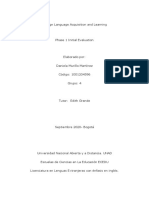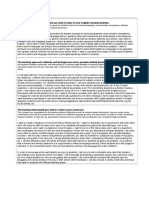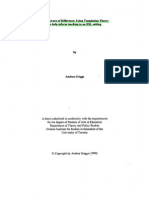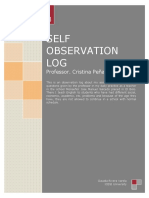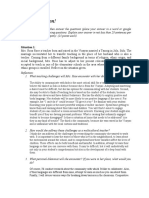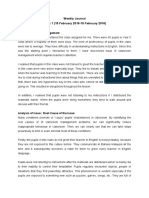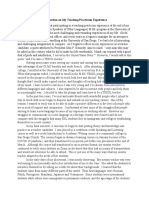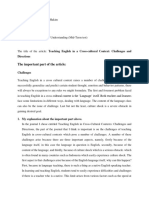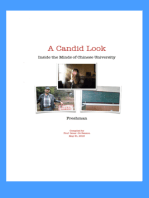Reflection Paper 2
Reflection Paper 2
Uploaded by
Khristian RossCopyright:
Available Formats
Reflection Paper 2
Reflection Paper 2
Uploaded by
Khristian RossOriginal Description:
Copyright
Available Formats
Share this document
Did you find this document useful?
Is this content inappropriate?
Copyright:
Available Formats
Reflection Paper 2
Reflection Paper 2
Uploaded by
Khristian RossCopyright:
Available Formats
Learner Differences
Reflection Paper #2
Khristian Ross P. Pimentel University of the Philippines Diliman, Quezon City EDFD 211
September 1, 2012
Preparing lesson plans and instructional materials are among the tedious tasks that a teacher like me should accomplish. Usually, I have to soak myself into being preoccupied for hours with these concerns to produce satisfactory results. I sometimes hate this responsibility yet I know that a well-prepared lesson will drive my students to learning. Undeniably, the most exciting part of my teaching career happens when I enter my classroom and interact with my studentsimplementing the things that I planned. Fulfillment resides within me when I witness my students learn and enjoy the discussion. However, not every meeting can turn to a Eureka moment. There are times that I feel frustrated because no matter how hard I try my best to teach, some students cannot understand, and some are unmotivated. It took me several experiences when I finally came to a point of realization about the culprit of this dilemma: learner differences. Since I was young, I know that everyone is unique. When I studied in college, professors kept on telling us to be prepared with various kinds of learners with different characteristics. When I started teaching, I have faced the reality that students from one another. These differences include gender, intelligence, learning style, language, special needs, and many more. As I stand in front of a sea faces, understanding the differences and making adjustments with my lesson have become part of my burden as an educator. After discussing the concepts in human development and the nature of learning in this class, knowledge about learner differences (besides knowledge about the subject matter) add an extra requirement that a teacher like me should possess. By then, I understand how crucial my job as a teacher. The succeeding lessons we had in the latter of August pertains to learner differences. If I would be asked what would be the most important lesson that I learned in class on the day that I submitted my first reflection paper, my answer would be about learning to be a Filipino. I did not
expect that the chitchat about Habagat will turn to a discussion about nationalism and its implication in education. Although I was not prepared for that kind of topic, I felt agitated because it has been the kind of discussion I have been longing for years. It is now that I finally understood the significance of the historical foundation of education though the topic focused on bilingualism. Although I am teaching English, I recognize the importance of the mother tongue not only for our cultural identity but also in learning a second language. I agree with Audrey when he said that a second language speaker must master his first language first before he can become fluent in the second language. The discussion turned into a Language/Linguistic class and we resolved an idea that because of our language has not fully developed, many of us are shallow thinkers. Because of colonialism and regionalism, we were not able to develop our language. According to Oliver Wendell Holmes, Language is the blood of the soul into which thoughts run and out of which they grow. I believe that language is a need to survive. This is true as I observed my students. Most of them are good speakers of English, but poor in Filipino. Many are really intelligent, but only few can express their thoughts well with conviction. As for me, I use Filipino when I reprimand my students because it is more powerful and sharper than any other language. One language sets you in a corridor for life. Two languages open every door along the way, Frank Smith said. Why do we teach other languages especially English? Ideally, English opens opportunity to students because it will make them globally competitive. English is also important for them to study other subjects since many textbooks and learning materials are written in English. Unfortunately, the effectiveness of this vision is always being contested because English language education in the Philippines has always been focusing in knowing
English than using it. I have been exposed in two different schools. My previous school really embraced the communicative language teaching and we focus on skills and literature and only few in grammar. My former students thought very well, and there were many times that they took incredible stance in our discussions. In my school now, we focus in grammar above all else and students are most of the time unmotivated when rules are lay down to them and all they need to do is to follow. Ironically, our English consultant who is already in his senior years always tell us not to teach our students to identify the subject and predicate, but he rejects the idea of revising the curriculum and changing our grammar-centered textbook. For me, rules are not what my students need. They need practice of using the language in the most authentic way. I was challenged with the call in molding the next great Filipino philosopher. As a language teacher, it is my burden to make my students think deeply and express themselves in the most excellent way. On the other hand, we have this English Speaking Policy that everyone should speak only English and Chinese when they are inside the school premises. I am not against to letting students speak in English, but I do not like how it is implemented in our school. We have this policy that anyone who will be caught speaking in Filipino will be given tickets which will mean demerit in their conduct grade. On the other hand, those who will be caught speaking in English will be given star stubs. My students can speak in English well and I believe that there is no need for them to be punished if they speak in Filipino or credited for speaking in English. Having knowledge about the cons of behavioristic motivation, I believe that rewards and punishment will not help our students to enhance their English communication skills. Aside from bilingualism, one concern that needs a nationalistic point of view is the issue about class size. I was fortunate before to have 30 students in one class. Compared before, it is
more difficult to handle more students in a class because it means extra work, extra effort, and extra headache for managing the class. Big class size, for me, posits only adverse effects. My responsibility and tasks has become broader since I am handling 40 students in a class. I cannot do group work activities that is as smooth as I had when I had fewer students. My time for class preparation diminished because I have to check more test papers and hence record more scores. My students have less opportunity to express themselves because of tight competition. Having a bigger class size, I, the teacher, should be the one to adjust. My foremost concern is classroom management. Every beginning of the school year, I see to it that classroom rules are properly disseminated among my students. I also used routines so chaos will be avoided in groupings, in discussions, and even in just mere submission of paper. When I give group activities, I also consider group selection and how to make students stay in task. As for checking and recording paper, I use class numbers to label each student. When a mild misbehavior occurs, I ignore. When two or more students misbehave, I become an avenger and hit two birds with one stone. I remember one funny incident when two of my students, Jerome and Mikael, misbehaved in my class. While I was discussing about a poem by Robert Frost, Jerome was doing his assignment in another subject and Mikael was consistently talking. I called the person Jerome and asked a question and I intentionally drop my chalk on the desk of Jerome and said Im sorry with ravenous sarcasm. Both of them stopped misbehaving. I realized then that since we cannot get rid of high class size, we should start devising strategies on how to cope up in this kind of situation. But if asked what solution will I suggest to solve this problem in public schools, my answer would be higher budget in Education, proper management in DepEd and
other sectors of education, and RH Bill. For me, its either improving our standard in education or lessening the population will provide our young people quality education. Talking about class size and bilingualism, I realized that socioeconomic status matters in education. I can testify that my students in private school are more fortunate than my students when I practiced teaching in a public school. My students who were not financially blessed continued to be oppressed in educational setting. Primarily, they have less exposure to educational activities outside school such as visits to museums, attendance at concerts, and borrowing books from the library. They also lack learning materials at home like dictionaries, computers, encyclopedias, and newspapers. They most likely dont have lessons outside my school like art, musical instrument, or dance. Compared to that majority who study in public schools, my students enjoy many of these privileges. I make an effort to let them realize these privileges and maximize their learning. I have a dream to work in public school and help the students there to achieve their dreams. Since I am teaching in the private school now, I also do that; but I always include values in my lessons that by the time that they will be successful in life, they will help their less fortunate fellow men. Meanwhile, Omar asked us why students do not listen in the classroom. Other than motivation alone, he reminded us that students have different facets of intelligence and thus different learning styles. I was actually expecting a discussion about Dunn and Dunn learning styles because it was something that I have forgotten already but when I searched for it instead, I realized various factors that make learning take place in the classroom. These factors or elements include environmental, emotional, sociological, physiological, and psychological. Before, I just implement my lesson as planned. After revisiting Dunn and Dunn paradigm, I am now more conscious what to consider if obstruction of learning takes place. As we begin the second
grading, some adjustments with the seating arrangement and more personal interaction with my students to address emotional needs are among the few things I have started to practice. I would buy the idea of Gardner of Multiple Intelligence because it is the saving grace that nobody is stupid, and everyone has his own intelligence. Having knowledge about multiple intelligences will help students to know their abilities and help them to choose their field of study in the future. I proctored the recently-conducted NCAE. I reminded my students when I reviewed them to take the test seriously so that they will receive accurate results. Awareness of the differences in learning styles and multiple intelligences among my students helped me decide teaching strategies that will fit to them. Since no one strategy can serve all learners, I always vary my teaching strategy. Since I started teaching, I have employed lecture, role-play, reporting, projects, viewing, games, reflective activities, simulation, and many more. However, I meticulously select the strategy appropriate for the class that I am handling. Sometimes, activities worked well in one class and not in another class so I always have Plan Bs. Actually, those activities do not only serve as an enjoyment among my students but it turned to be an entertainment to me as well. Some of the most memorable activities that I had so far were all the student-centered lessons that I facilitated especially the role-playing because students learn and enjoy at the same time. However, evaluation is the only major problem that I can see because based on my experience, the schools that I have been working with is not ready for authentic assessments which I think can measure skills and abilities that paper and pen test cannot. In relation to learning styles, we cannot deny the fact that schools have embraced the idea of bringing technology in the classrooms. Majorityif not all my studentsare using products of technology. Many of them are astounded when I use technology in the classroom especially
when I use something for the first time. When I was teaching World History in my first year of teaching, I asked my students to conceptualize their own movie to tackle historical events, and they only need to make a trailer and movie poster for that. My students enjoyed in making the output, and they were commended by the administrators. In addition, I consider using INTERNET as a tool in learning. Our school subscribed in World Book Online, and we encouraged our students to visit the site, read articles, and watch videos. Facebook and E-mail have also assisted me and my students. It plays a major role in my teaching now because my students can ask me questions through chat and can clarify lessons through threading, and I can send PowerPoint presentations through mails and groups. Using videos in the delivery of content was at least equally effective as traditional teaching lectures. Students learn more deeply from words and pictures than words alone. I was using a rap video about the elements of the story. I was never successful in teaching it to my students until I used that video because they told me that they really had last song syndrome with the lyrics of the song. Another difference that is evident among students is gender. Males are different from females and vice-versa in terms of physical characteristics and abilities and social behavior. Knowing these differences, my role as a teacher is to avoid gender stereotyping, give equal opportunities to both gender, and help my students reach their full potential as male and female. In relation to gender, Allan made a research about the probability of homosexuality among exclusive schools. His findings about SSAD were very evident with my 6 homosexual female students in my previous school as I talked with their parents during PTC. Most of them have personal issues with their family and friends. However, I have my own assumptions. Based on what I know, most of the exclusive schools in the Philippines are run by religious sects. Sex
issues are taboo topics in those schools and since the students are in the adolescent stage who has identity crisis because of the changes in their body found no outlet for their questions. I remember a friend of mine told me that even pictures with genital exposure were covered in those schools way back then. Homosexuality is not only an adverse effect of single-sex school but also early committal of sexual activities. Aside from gender, students differ also in learning abilities. Julie oriented us about mainstreaming and inclusion to address the learning necessities of students with special needs. My first year of teaching let me experience a class with inclusion. In my first week, I divided the class into groups for a task. My attention was caught by Tommy Boy who kept on talking. I kept on shouting and reprimanding him. It was late when my students informed me that Tommy is hearing impaired. Because of that, I looked for the list of students who will attend my class who are SSN and I found many names. I have RJ with behavior problem, Austin with Autism, and Christelle with Global Development Delay. Being aware of their status, I see to it that they are physically and mentally present in my class. I have another student named JV and Ron. JV is always bullied because he is an overachiever, but he has autism. I always call him in recitation, and he always has an answer to me. I remember Ron who is in my advisory class. He is autistic also. He loves routine and he cries and gets frustrated if things changes. I always remember when I put anything on the rightmost part of the board, Ron will raise his hand and confirm to me if thats an assignment. He always greets me, smiles at me, and waves his hand. Even when Im working in the faculty room, he will wave his hand to me since Im near the window. Nico has ADHD and autism, but he is really talented. When I asked them to make a t-shirt design and model it, he was among the
students who did their best pose. I will never forget those experiences because I was given a chance to be part of their lives and appreciate their abilities and recognize their existence. Students have diverse levels of motivation, dissimilar attitudes about teaching and learning, and different responses to specific classroom environments and instructional practices. The more thoroughly we understand the differences, the better chance we will have of meeting the varied learning needs of all of our students. When I started teaching, I have so many questions then: what, when, where, and who to teach; but I realized that the most important question is how and why we teach. Thats the reason why Im still here.
You might also like
- RD Sharma Class 8 Full Book PDF (Mathematics)Document687 pagesRD Sharma Class 8 Full Book PDF (Mathematics)Mahati P78% (532)
- Example of Narrative Report Progress 2Document22 pagesExample of Narrative Report Progress 2Sophia Grace NiduazaNo ratings yet
- 7 Reflect ZoneofproxDocument5 pages7 Reflect Zoneofproxapi-315537808No ratings yet
- Criminology Graduate Application Letter For InstructorDocument1 pageCriminology Graduate Application Letter For InstructorRERREFAIT91% (22)
- Ci 280 FinalDocument7 pagesCi 280 Finalapi-449524522No ratings yet
- Summative Reflective EssayDocument6 pagesSummative Reflective Essayapi-242024655No ratings yet
- Phase 1 Foreing LanguageDocument3 pagesPhase 1 Foreing LanguageDanielaNo ratings yet
- EDU 202 Portfolio Artifact # 1 - Philosophy of EducationDocument7 pagesEDU 202 Portfolio Artifact # 1 - Philosophy of Educationapi-549461032No ratings yet
- Lesson Plan Romantic PeriodDocument3 pagesLesson Plan Romantic Periodjordanjefferson89% (9)
- Classroom Cultural Diversity Formal Observation #2 EDTE 255 Jazmine LoaizaDocument5 pagesClassroom Cultural Diversity Formal Observation #2 EDTE 255 Jazmine Loaizaapi-357628082No ratings yet
- Ell ReflectionDocument5 pagesEll Reflectionapi-513755817No ratings yet
- Teacher Work Sample: Mitchell CarnahanDocument21 pagesTeacher Work Sample: Mitchell Carnahanapi-253272691No ratings yet
- Autobiographic Essay: 1 Txgb6105 Language AcquisitionDocument7 pagesAutobiographic Essay: 1 Txgb6105 Language AcquisitionmegavinNo ratings yet
- Solution Proposal Response: Introduction/BackgroundDocument10 pagesSolution Proposal Response: Introduction/BackgroundMicah J FordNo ratings yet
- Reflection Essay TwoDocument4 pagesReflection Essay Twoapi-273322134No ratings yet
- Oral Language AssessmentDocument5 pagesOral Language Assessmentapi-242291277No ratings yet
- Field Experience Portfolio: Thomas Jefferson Elementary School - 2 Grade ClassroomDocument26 pagesField Experience Portfolio: Thomas Jefferson Elementary School - 2 Grade Classroomapi-493639506No ratings yet
- Beatrice Hersh-Tudor FRE496 Philosophy of Foreign Language TeachingDocument7 pagesBeatrice Hersh-Tudor FRE496 Philosophy of Foreign Language TeachingBea Hersh-TudorNo ratings yet
- Top 10 Synthesis ECI 540 Carolina MusawwirDocument10 pagesTop 10 Synthesis ECI 540 Carolina Musawwirapi-400078361100% (1)
- Field LogsDocument6 pagesField Logsapi-302308561No ratings yet
- Professional DevelopmentDocument5 pagesProfessional Developmentapi-302421213No ratings yet
- Teaching Philosophy: Dan Zhong HI ED 546 College Teaching Assignment 4-Teaching PhilosophyDocument4 pagesTeaching Philosophy: Dan Zhong HI ED 546 College Teaching Assignment 4-Teaching PhilosophypurezdNo ratings yet
- Interview Questions and Answers Marie Wallace Third Grade Jefferson Elementary Unit 1. DemographicsDocument3 pagesInterview Questions and Answers Marie Wallace Third Grade Jefferson Elementary Unit 1. Demographicsapi-395837744No ratings yet
- Classroom OverviewDocument1 pageClassroom Overviewapi-283707491No ratings yet
- English Language Arts LiteracyDocument11 pagesEnglish Language Arts Literacyapi-621531450No ratings yet
- Professional DevelopmentDocument4 pagesProfessional Developmentapi-302422167No ratings yet
- My Literacy Narrative - Nicholas VetriDocument6 pagesMy Literacy Narrative - Nicholas Vetriapi-608775651No ratings yet
- The Path Leading To Differentiation: An Interview With Carol TomlinsonDocument10 pagesThe Path Leading To Differentiation: An Interview With Carol Tomlinsonapi-284511189No ratings yet
- Literacy PortfolioDocument9 pagesLiteracy Portfolioapi-492081206No ratings yet
- Teaching Philosophy FinalDocument3 pagesTeaching Philosophy Finalapi-335073698No ratings yet
- Final AbeDocument11 pagesFinal Abeapi-487844240No ratings yet
- My Teaching PhilosophyDocument2 pagesMy Teaching Philosophyapi-322894744No ratings yet
- l408 FinalDocument10 pagesl408 Finalapi-524533855No ratings yet
- Student Teaching Reflection 12 10 15Document2 pagesStudent Teaching Reflection 12 10 15api-284550242No ratings yet
- Final FS 2 UpDocument11 pagesFinal FS 2 UpEmpress Cris TVNo ratings yet
- Quinty LearningenvironmentpaperDocument2 pagesQuinty Learningenvironmentpaperapi-313684895No ratings yet
- Section Two Teacher Candidate Background ExperiencesDocument17 pagesSection Two Teacher Candidate Background Experiencesapi-291679641No ratings yet
- BV-TRA-EDU-Using Translation Theory To Help Inform Teaching in An ESL SettingDocument124 pagesBV-TRA-EDU-Using Translation Theory To Help Inform Teaching in An ESL Settingtoopee1No ratings yet
- Focal Student PortfolioDocument38 pagesFocal Student Portfolioapi-293432552No ratings yet
- Student: Emiliano Sebastian Torres Tealdo Tutor: Cecilia ZemborainDocument4 pagesStudent: Emiliano Sebastian Torres Tealdo Tutor: Cecilia Zemborainmarta zardimNo ratings yet
- Setting and Context NewDocument8 pagesSetting and Context Newapi-257634244No ratings yet
- Interview With The HeadDocument4 pagesInterview With The Headapi-351825683No ratings yet
- 11 21 AssignmentDocument5 pages11 21 Assignmentapi-577230763No ratings yet
- Professional DevelopmentDocument9 pagesProfessional Developmentapi-301419574No ratings yet
- SIB Example Fall 2011Document8 pagesSIB Example Fall 2011CarolBillingCWINo ratings yet
- Self Observation LOG: Professor. Cristina PeñafortDocument7 pagesSelf Observation LOG: Professor. Cristina PeñafortKlau Rivera VarelaNo ratings yet
- Gillinpersonalpedagogy 2Document4 pagesGillinpersonalpedagogy 2api-341633682No ratings yet
- Uligan, Rose Angela FINAL PAPERDocument12 pagesUligan, Rose Angela FINAL PAPERroseNo ratings yet
- FS 1 Ep 3Document10 pagesFS 1 Ep 3Jon Watthapan MejaresNo ratings yet
- Service Learning Reflective Summary Report CorrectDocument16 pagesService Learning Reflective Summary Report Correctapi-303140970No ratings yet
- Cómo Vas A Hacer La Revolución en La Enseñanza de L2Document2 pagesCómo Vas A Hacer La Revolución en La Enseñanza de L2Rut Suarez garciaNo ratings yet
- Professional Development ReflectionsDocument6 pagesProfessional Development Reflectionsapi-300370981No ratings yet
- Mancilla Assignment4Document11 pagesMancilla Assignment4api-295073409No ratings yet
- Karen Balanag - Make A Reflection1Document2 pagesKaren Balanag - Make A Reflection1Karen Balanag100% (1)
- Weekly JournalDocument6 pagesWeekly JournalLow100% (1)
- Practicum Reflection JournalDocument42 pagesPracticum Reflection Journalapi-320798317No ratings yet
- A Reflection On My Teaching Practicum ExperienceDocument4 pagesA Reflection On My Teaching Practicum Experienceapi-610253691No ratings yet
- Teacher Philosophy 2Document6 pagesTeacher Philosophy 2Kobri003No ratings yet
- Context of Learning Paper 1Document6 pagesContext of Learning Paper 1api-282592533No ratings yet
- Scholarly Article ReviewsDocument8 pagesScholarly Article Reviewsapi-362414886No ratings yet
- 039 Adam Amirul Hakim B6BIR CCU Mid-Term TestDocument5 pages039 Adam Amirul Hakim B6BIR CCU Mid-Term TestIryul AdamNo ratings yet
- Running Head: Bechara-Week1 AssignmentDocument8 pagesRunning Head: Bechara-Week1 Assignmentapi-362170340No ratings yet
- Learning to Read in English and Spanish Made Easy: A Guide for Teachers, Tutors, and ParentsFrom EverandLearning to Read in English and Spanish Made Easy: A Guide for Teachers, Tutors, and ParentsNo ratings yet
- A Candid Look Inside the Minds of Chinese University FreshmenFrom EverandA Candid Look Inside the Minds of Chinese University FreshmenNo ratings yet
- Eapp PrintDocument6 pagesEapp PrintAngela Reyes89% (9)
- Handouts Day 2 Differentiated MaterialsDocument15 pagesHandouts Day 2 Differentiated Materialswai jiun mayNo ratings yet
- Shogun (Toolbox)Document3 pagesShogun (Toolbox)levin696No ratings yet
- How To Write German NumbersDocument7 pagesHow To Write German NumbersbinodthakurNo ratings yet
- What Do The Key HSC Verbs Really MeanDocument2 pagesWhat Do The Key HSC Verbs Really MeanmostdefinitelyNo ratings yet
- Segway Clone ModelDocument9 pagesSegway Clone ModelHugo FrenchNo ratings yet
- Unit Plan Reading in A Multicultural Classroom Japanese Girls Day LessonDocument6 pagesUnit Plan Reading in A Multicultural Classroom Japanese Girls Day Lessonapi-322101445No ratings yet
- The Audiolingual MethodDocument3 pagesThe Audiolingual MethodImelda MallipaNo ratings yet
- RfC1A TG End-Of-Course Listening TestDocument6 pagesRfC1A TG End-Of-Course Listening Testqq8678081060% (1)
- Lesson PlanDocument13 pagesLesson Planapi-276183071100% (1)
- Natwest - Applied ListDocument22 pagesNatwest - Applied ListsuryaNo ratings yet
- Suicide: Is The Intentional and Voluntary Taking of One's Own LifeDocument2 pagesSuicide: Is The Intentional and Voluntary Taking of One's Own LifeNuhr Jean DumoNo ratings yet
- Meg-02 Assignment 2021-22Document4 pagesMeg-02 Assignment 2021-22Aakif SalamNo ratings yet
- Book Published I Field of BusinessDocument189 pagesBook Published I Field of BusinessRikeshNo ratings yet
- Practical Research 2 Module 5: Write A Research TitleDocument4 pagesPractical Research 2 Module 5: Write A Research Title306947 Bancal Pugad ISNo ratings yet
- Brigada Eskwela Service CreditsDocument1 pageBrigada Eskwela Service CreditsKhulyn Castro AlvarezNo ratings yet
- Gr.2 Template Feeding Beneficiaries 2020 2021Document6 pagesGr.2 Template Feeding Beneficiaries 2020 2021Jesusima Bayeta AlbiaNo ratings yet
- Q4 HE Cookery 7 8 Week1Document4 pagesQ4 HE Cookery 7 8 Week1Alexander Garcia100% (1)
- Topics For VocabularyDocument5 pagesTopics For VocabularycataleayNo ratings yet
- Nouns 7Document2 pagesNouns 7Rouble PaulNo ratings yet
- Sap AbapDocument2 pagesSap AbapAlfaaz Hosayn50% (2)
- BOTANY THIRD - PAPER (Pteridophytes, Gymnosperms and Palaeobotany)Document3 pagesBOTANY THIRD - PAPER (Pteridophytes, Gymnosperms and Palaeobotany)GuruKPO100% (1)
- 101 2023 0 B PDFDocument17 pages101 2023 0 B PDFTshikani JoyNo ratings yet
- ListDocument6 pagesListImamNo ratings yet
- Historical Thinking SampleDocument19 pagesHistorical Thinking Sampleeksiltilicumle9938100% (1)
- Assignment-1 (MLP From Scratch) : Roll No: EDM18B055Document1 pageAssignment-1 (MLP From Scratch) : Roll No: EDM18B055CED18I054 V S PRAVEENNo ratings yet






